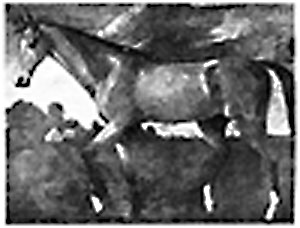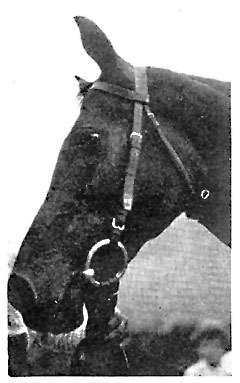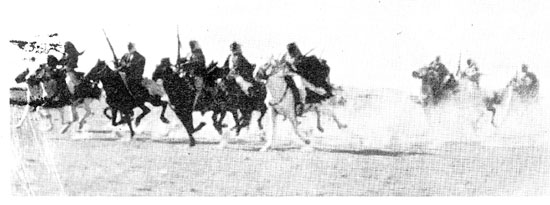 |
|
Reading Raswan |
 |
![]()
| MUNIQI ARE THE
most distinct type of Arabians, being much the largest , with angular
instead of rounded outlines, rather plain (often coarse) and very fast
up to four miles. Speed proved to be the most outstanding quality of the
MUNIQI throughout historical records. They are the
Thoroughbred type among the horses of the desert.
The ancient strains, KUHAYLAN and SAQLAWI, have existed 3000 years and the MUNIQI have existed since the time of Muhammad, or about 1200 years. |

Typical Muniqi head of horses bred pure-in-the-strain. |
| This speed type have very straight hind legs, often drooping hind
quarters and low tail carriage, points which are of advantage to a race
horse only, necessarily of the greyhound build. Built for speed and with
plenty of bone, they have the shortest cannon bone, the longest longest
forearm and large flat joints (knees and hocks). Their necks are extraordinary
long -- hence their name "MANAQ -- long necked," a name given
by the Bedouins to their gazelle hounds also. The head is longer, matching
the lines of the body. Profile of face below the orbits is straight with
eyes set very high. Average height, 15 hands. Color, mostly chestnuts,
with some bays.
There are two variations: the MUNIQI-HADRUJ, which are the true angular, long-bodied race type, and the MUNIQI-SBAILI, which fit more in a square than oblong frame. The SBAILI resemble the SAQLAWI when in motion only, neck arched, tail carried high, but they are narrow throughout, noticeable even between the jowls. Greys appear among the SBAILI. I have never seen a grey (white) HADRUJ. To my knowledge only Homer Davenport, Randolph Huntington and Ameen Rihani ever brought pure strain HADRUJ of racing type to America, but not one offspring which can be traced pure-in-the-strain exists today in this country. By this I mean tracing from both sides. Some almost pure horses of this strain were El Sabok 276, Matih 469, and in Canada, Nasin 541, and five others in the U.S.A. almost as rich in the blood. They are worth their weight in gold if someone could pick them up and create a stud to save their priceless blood, to which traces the English race horse. This MUNIQI blood came through the Darley Arabian in 1703 as the most important stimulus to the creation of race horses. It roused to greatest speed and spurred to highest action the vital powers of English horse flesh. |
|
|
|
|
WE IN AMERICA could have preserved this rarest
blood at various times during the last fifty years. Randolph Huntington
owned a collection of four mares and a stallion of pure MUNIQI-HADRUJ,
but Huntington's heirs did not continue the strain breeding and no one
else has since. The story of how this blood went to England follows.
TOWARDS THE end of the seventeenth century the wandering Arabs, the Bedoiuns of Nejd (in the neighborhood of the Nufud Desert), had left their homeland in the very heart of Arabia. Successive years of drought and famine forced several tribes to migrate to search of better pastures in the far distant north Arabian wilderness. One particular tribe, the Fid'an, a section of the 'Anaza people, with their camel herds and horses actually crossed the chain of hills that stretches from Damascus to the banks of the Euphrates near Deyr-ez-Zor, and appeared in the immediate neighborhood of Aleppo. MR. DARLEY, British Consul at that time in Aleppo, was a sportsman of no unusual qualities, but with intuitive insight (in another country they would call him a "patriot with his country's welfare at heart"), and out of his love of horses, interested himself in the life of these strange Bedouins that had appeared out of the wilderness to spend the summer months so far north -- a thousand miles distant from their ancient pasture-grounds in the neighborhood of the holy city of Medina. |

Start of the race between Amsha and Shiha at Bir Kasab in which the chestnut mare Shiha won. Shiha is third from left. |
|
MR. DARLEY became a friend of their Sheykh, went hunting with their old chief, falcon on wrist, and Salukis, fleet Arabian greyhounds, coursing beside their galloping mares. He gained an intimate knowledge of the rare Arab horses, and, what was more, he knew their points. He overlooked purposely the antique or muscular and handsome types, and marked down the angular, lean, long bodied, greyhound-like strain of the MU'NIQI, the racehorse type, and found a pure stallion which, though on the small side he knew could be successfully mated with a large mare in England to produce an offspring of the size of the dam and not of the sire. It would have been difficult to acquire a mare, and so he selected MANAK (undoubtedly a stallion of the MU'NIQI strain) and shipped this horse to England in 1703. Mr. Darley's brother, of ALDBY HALL, YORKSHIRE, received this most valuable of all Oriental horses that ever reached Europe within historic times. Ten years, however, elapsed before the "DARLEY Arabian," this stallion MANAK, produced Flying Childers. The first volume of the English Stud Book was not published until 1808, but, from the time of the Darley Arabian on, there had been an attempt to collect and preserve pedigrees and records. THE FOUNDATION of the Thoroughbred horse rests solidly and historically on this stallion named Manak (the Darley Arabian, ancestor of Eclipse) and two other near Eastern horses -- the Byerley Turk (1683), from whom Herod was descended, and the Godolphin Barb (1730). SINCE MUNIQI strains have been mixed so much into our other strains of horses in America I want to draw attention to the following: THE FIRST and second cross of MUNIQI with KUHAYLAN or SAQLAWI will generally disappoint the breeder because the offspring will not follow either strain in type. From the third generation on they will adopt either type but there is no telling which, unless the blood lines of one strain have been predominant in past generations and is continued in the future. IT IS almost impossible for any Arabian horse in America to be influenced by the type of MUNIQIYAT because there are less than a dozen of them in the U.S.A. and Canada with the predominant MUNIQI pedigrees. For this reason I predict that with two more horse generations we will have bred back to the antique type. For instance, the famous Stock Horse Farana, registered as a MUNIQI-SBAILI, is only one-eighth MUNIQI, being five-eighths KUHAYLAN and one-quarter SAQLAWI. Minute examination of this horse will disclose he is not of the MUNIQI type. This applies to most MUNIQI horse in America and England today, outstanding examples being Ferhan, Faris, Fasiha, every one only one-eighth MUNIQI. IT HAS BEEN sometimes suggested that here in America we could discontinue keeping track of the Arabian strains, because many of our horses are not rich in the blood lines of the family and strain name they have been registered under. I maintain, however, these strain names are very important in tracing pedigrees and that they give us our last opportunity, for those who care to use it, to retrace the origin of Arabian horses. My own system of doing this is by underscoring each name in a pedigree with different colored pencils, using blue for the KUHAYLAN and related strains (HAMDANI, HADBAN) -- red for the SAQLAWI and related strains (DAHMAN, ABAYYAN, etc.) -- brown for the MUNIQI and related strains (JILFAN, RABDAN, ABU URQB, etc.). WHEN A pedigree is underscored by color in this fashion, one glance at it will disclose the predominant color, or strain, of the animal being analyzed. By breeding this animal to individuals predominant in the same blood, the types can be reproduced with mathematical regularity and there is no guess work. THE DIFFICULTY of understanding the tracing of strains in this country seems to have arisen from tracing on the dam's side rather than the sire's. The custom originated in Arabia where the legend goes, Ishmael caught a wild mare, the KUHAYLAH, pregnant with a stallion colt which in turn took the mother's name and conceived the first strain by incest breeding. This practice has been carried through all other strains later developed from the blood of the original mare and her son. See fist and second articles of this series. THE MARES of the desert are more important to the Bedouins than the stallions, which they never use as war horses. She is supposed to give the frame, size and type. They say she is the soil or substance in which the qualities and properties of her ancestors have been vested. Stallions transmit the temperament and nervous makeup and most important they emphasize not only the qualities but also the faults of the mare. THE ENGLISH (Weatherbys Stud Book) were the first to adopt the registration of Arabs tracing the strain on the dam's side.
THE DEMAND for Arabian race horses in Poland, Egypt, Syria, Iraq and India brought out the fact that the MUNIQI and related strains had above all more size, bone and speed. The Bedouins of Arabia have no particular use for race horses except for hunting. They do run a few races for their own pleasure, as I saw happen when human slaves were the stakes. SHAYKH SALLAL IBN HEJNA of the Atayban arranged for a race of his chestnut mare Shiha, a Mu'niqiyah-Hadrajiyah, against a grey mare of his enemy Mutlaq ibn Wayil (of the Shammar). Wayil's mare was Al-Amsha', a Jilfah Sittam Al-Bulad. Just a week before the appointed time for the race, which was to take place at Tarfiyah, Province of Qasim, Central Arabia, Wayil's grey mare Al-Amsha' was stolen by the Ruala. TWO YEARS later the stolen mare fell into the hands of the Shaykh of the "Amarat in one of his raids against the Ruala. I happened to "share" the stolen mare with Jluwi, one of the slaves of Prince Nuri of the Ruala, who had supplied the race camel to which I had tied the mare. AMONG THE enemies who had overtaken us at Birkat al-'Ashaq, was Sallal, who happened to be a guest of the raiders (very much as I was a guest of the raiding party to which I belonged). Sallal recognized at once the stolen mare as the one against whom he had offered to race his own mare two years previously. SALLAL BOUGHT the stolen mare from the leader of the raiding party which had captured us and I arranged that I could return with our enemies to the pastures of the southern Wudyan and with Sallal and the recovered mare to Hafar in the depression of Al-Batn and to Kuwayt. With the help of the Shaykh of Kuwayt my generous companion Sallal returned the stolen mare to his enemy, Mutlaq and challenged him again to race his recovered mare Amsha' against Shiba (Sallal's own mare, the Mu'niqiyah, with two slaves as stakes). SEVEN MONTHS after this last event the race between Amsha' and Shiha took place at the gates of Kuwayt. THE STOLEN grey mare, Amsha', won by almost two lengths over a distance of about a mile and a half and the generous Sallal lost his slave. The Mu'niqiyah (the one who had lost) was acquired by Shaykh Farhan ibn Sha'lan of the Ruala and often raced at the turf clubs of Basrah and Baghdad (1929-1932). Later Farhan brought her to Amir Fuaz of the Ruala as a gift. The stolen grey mare (the Jilfah) also won races in Iraq and was later sold to Shaykh Mijhem ibn Meheyed of the Fida'n, who gave her as a present to Mr. Ibish in Syria. AGAIN TWO years later Prince Fuaz, the new owner of the chestnut mare Shiha (the Mu'niqiyah mare), challenged Mr. Ibish to race Al-Amsha' (his grey Jilfah mare) against his own. None of the men knew that the two mares had been raced against each other previously and I kept silent about what I knew. THE RACE was held at the wells of Bir Kasab, not far from Mr. Ibish's country estate at the edge of the desert between Damascus and east of the Hauran mountains. THE MU'NIAIYAH and Jilfah were a perfect match up to almost two miles and raced neck and neck, but after that Shiha, the chestnut Mu'niqiyah, just drew away from Al-Amsha' and left her way behind. THIS STRANGE coincidence made me realize that in Arabia, as spacious as it is, and as (relatively) great a number of horses as I have known there, two good race horses cannot be left unmatched. UP TO THE year 1900 about 1500 to 3000 young colts were exported each year from Arabia by way of Basra and Kuwayt on the Persian gulf. Since the last World War most such colts and young stallions bred among the Bedouins of eastern Arabia are brought to the race tracks of Baghdad and Basra. The Syrian Bedouins and other nomads of Western Arabia sell their colts and stallions to Agheyl, camel and horse traders, who take them to the race tracks of Beyrouth, Cairo and Alexandria, where they are matched against each other and against so-called country bred native Egyptian horses. The Arabian horses which show up on the Baghdad and Basra tracks are mostly of the MUNIQI and related strains, JILFAN, RABDAN, SAMHAN, ABU URQUL, etc. Also of less important sub-strains, KUHAYLAN- MIMRI, KHARAS, SAQLAWI-ARHABI, SAQT.ABAYYAN-HUNAYBI, KHARISH, HAMDANI-JIFLI, HADBAN-BARDAWIL, DAHMAN- KUNAYHIR, SHUWAYMAN-AMIRIYAH, etc. THE BIG winners on the race tracks of Iraq usually sell to India, where they are raced in Bombay. The top horses are picked up by British sportsmen and officers. Sometimes outstanding Arabs from this top stratum after winning against all competition are found worthy to be taken to England, like Kismet, Maiden, and a few others. On checking their pedigrees they are found to be of MUNIQI and related strains. The MUNIQI-HADRUJ of the Kismet, Maiden, Naomi, Khaled, Nimr. Yataghan, Haidee blood lines are the most important in America as far as speed, size, and bigger bone are concerned. THERE ARE seven related strains. Strangely the relatives of these racers are not uniform to the parent type as are the related strains of the KUHAYLAT and SAQLAWIYAT. Each of the seven bear more or less resemblance to the ancient family. 1. ABU-URQUB: KUHAYLAN influence, rounded outlines, masculine, tall, plain but not coarse, big bone with large hock (hence their name) and knees, rather high legged. Head-heavy, meaty, plain, small eyes set high, narrow jowls. 2. JILFAN: resembling HAMDANI but more rangy, large, high legged, deep chested but narrow, drooping hind quarters and tail. Good jumpers and fast runners. The Godolphin Barb or Arab whose name was Sham,which means Damascus, and indicates that he was a Syrian and not an African or Barb, was a JILFAN. Most of these horses I have seen were greys, flea-bitten as they became older and every one was over 15 hands. Their eyes are small, set high and narrow jowled, neck long, flat and set high. 3. KUBAYSHAN: HAMDANI type but smaller and fast at short races. A rare strain rather handsome built but with a plain head and a low tail carriage. 4. MUKHALLAD: largest of all Arabians, 15 to 16 hands, big bone, high legged, stylish to almost feminine with high tail carriage but plain long head with small eyes and narrow jowls. Make good jumpers. 5. RABDAN; SAQLAWI type with rounded outlines, racing legs, plain straight head and narrow between the jowls. Average height 15 hands, color mostly dark chestnut, tail carriage high. 6. SADAN: long and rangy like MUNIQI but small and fine bone. Fourteen hands average height but rather handsome, fast but not as enduring as the ancient types. Their eyes are small and they have narrow heads. 7. SANHAN: large bodies and long lines, big bone, muscular but light in front. Their heads are long and straight with small eyes. Tail carriage is high. |
|
Davenports: Articles of History Arabian Visions' |
This page hosted by ![]()
Get your own Free Home Page